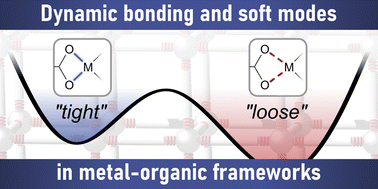Dynamic metal-linker bonds in metal–organic frameworks
Abstract
Metal-linker bonds serve as the “glue” that binds metal ions to multitopic organic ligands in the porous materials known as metal–organic frameworks (MOFs). Despite ample evidence of bond lability in molecular and polymeric coordination compounds, the metal-linker bonds of MOFs were long assumed to be rigid and static. Given the importance of ligand fields in determining the behaviour of metal species, labile bonding in MOFs would help explain outstanding questions about MOF behaviour, while providing a design tool for controlling dynamic and stimuli-responsive optoelectronic, magnetic, catalytic, and mechanical phenomena. Here, we present emerging evidence that MOF metal-linker bonds exist in dynamic equilibria between weakly and tightly bond conformations, and that these equilibria respond to guest–host chemistry, drive phase change behavior, and exhibit size-dependence in MOF nanoparticles.

- This article is part of the themed collection: 2024 Frontier and Perspective articles


 Please wait while we load your content...
Please wait while we load your content...